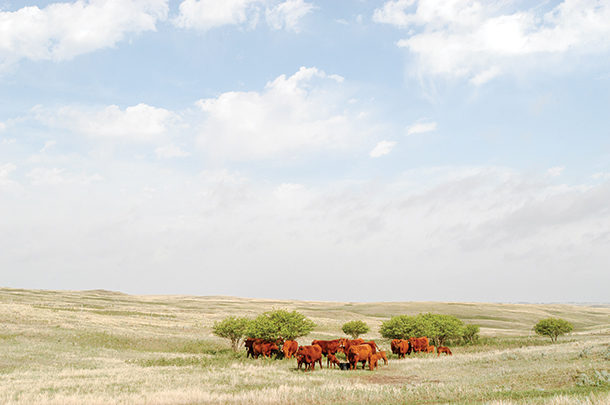Some may think the topic of rangeland management is limited to vast Western rangeland and public lands that include livestock grazing. Those areas likely get the most notice and scrutiny, but rangeland management principles apply to pastures as small as just a few acres to a few thousand.
Range management covers a wide array of subjects including plant identification, soil health, monitoring methods, ecology, wildlife management, forage production and inventory, supplementation strategies, grazing systems and livestock production.
Range specialists and beef nutritionists alike would strongly advocate for the education of all topics to help better our grazing livestock industry. Listed in this article are some key observations noted from working with livestock graziers and professionals.
Have a grazing plan
The goal of a grazing plan is to apply best practices that fit the resources available and the goals of the grazing operation. The concept sounds simple, but implementing can be more of a challenge as grazing plans encompass numerous different management strategies that will constantly change or evolve.
Key parts of a grazing plan would consider the type of soils, potential forage production, plant composition and water availability and infrastructure. Then the correct stocking rate would be matched to the system; continuous, rotational, managed intensive grazing systems (MIG), etc. These types of systems have variations among them and would look different for different types of pastures being used, i.e., rangeland pastures versus irrigated pastures.
Ask for help in developing a good grazing plan or to have your current plan reviewed. It’s beneficial to obtain perspective and expertise from those familiar with the varied management strategies and challenges. Local cooperative extension or USDA Natural Resource Conservation Service (NRCS) personnel are very good resources.
Understand real problems and threats, address them early and don’t overlook
Part of a grazing plan is obviously to prevent overgrazing – and not just in the sense of gross mismanagement or abuse. Overgrazing may be occurring without anyone knowing it through poor grazing distribution, by improper timing of grazing or not resting pastures long enough.
Overgrazing can lead to soil erosion and create a greater chance for other problems such as soil compaction and invasive species or noxious weeds. If you don’t know what plants are termed noxious weeds in your state or county, you should familiarize yourself with these and how to control them.
We may all agree that Canada thistle or leafy spurge are obviously bad weeds, but have we thought about slower-encroaching species such as eastern red cedar? Cedar encroachment in pastureland of the Central Plains has become an important issue and, if not controlled, can have a significant impact of range productivity over a 10- to 20-year period.
Monitor conditions for continuous improvement
The use of various rangeland monitoring methods is a way to measure or track how well your management practices are working. Monitoring looks at plant communities, productivity and soil health over time. Monitoring is a lot like a “before and after report” and often can be reported with site-specific photos of progress over time.
Monitoring can help prevent a problem with pasture health or productivity before it’s that noticeable and be a decision tool for changes. It also collects and builds a database of information regarding responsible stewardship practices and success stories. This information may even prove invaluable, as it’s proof to the value of grazing and could be used to defend your management, advocate best practices and encourage other land managers to do the same.
Good land managers need to be visible and make their success known. There are more good cases than bad but, unfortunately, some may recognize a field infestation of musk thistle or an eroded hillside before they’ll notice good management practices.
Supplementation is a part of pasture and range management
Forage alone is not always enough. If we could only graze pastures during a time when the available forage met all the requirements of cattle, we’d be grazing very few days. As plants grow and mature, they become lower in crude protein and higher in fiber and lignin levels. Vitamin and mineral content follow the same pattern. Digestibility decreases as does available nutrients.
This is where supplementation strategies can be used to maintain the performance of those grazing animals, thus keeping them grazing for more days. This strategy is much less expensive than simply taking the animals off the pasture and feeding them. The key is to have an adequate quantity of standing or stockpiled forage to graze, and this can relate back to the type of grazing systems being used.
Supplements can be used beyond their nutritional value. Improved grazing distribution is key to any grazing plan and, in many situations, pastures may be overgrazed in one area and underutilized in another. This is due to topography, water location, forage quality and even animal behavior. Water development, fencing and herding are longtime practices to best distribute livestock on grazing land.
More recent studies and practices, however, have shown the value of strategic supplement placement to attract cattle to areas where more grazing is desired in underutilized areas. These areas may be far from water or in rough terrain. The net result of this practice is more grazing days through improved distribution. This utilizes the available resource while also relieving pressure on areas that may tend to be overgrazed, such as riparian zones or near watering structures.
Many different self-fed supplement types and forms have been used for this practice, including salt, but the best results have been shown with low-moisture molasses-based supplement blocks. These supplements are very palatable and preferred by cattle versus other forms.
Advocate and share success stories
Livestock and livestock grazing have been unfairly blamed for human health problems, climate change, endangered species and poor water quality, but it should be the opposite, as the industry has done a great job of promoting rangeland health and quality through good management.
Overall, I believe our pastures and rangelands are much better managed today than 50 years ago – and undeniably better than a century ago. Rangeland management is about continuous improvement, stewardship and sustained productivity, and the success stories need to be shared.
Land is a finite resource, and we are demanding more food production today from a shrinking amount of land used for agriculture. There is competition for this land, be it for grazing, recreation or urban sprawl. Limited available pastureland and the cost of what is available for lease or purchase can be a deterrent to the expansion of grazing animal numbers in many communities.
So for grazing operations to be profitable, good management is key. Our industry should also be a strong advocate for responsible stewardship and sharing those benefits to the agricultural community and the public at large.








